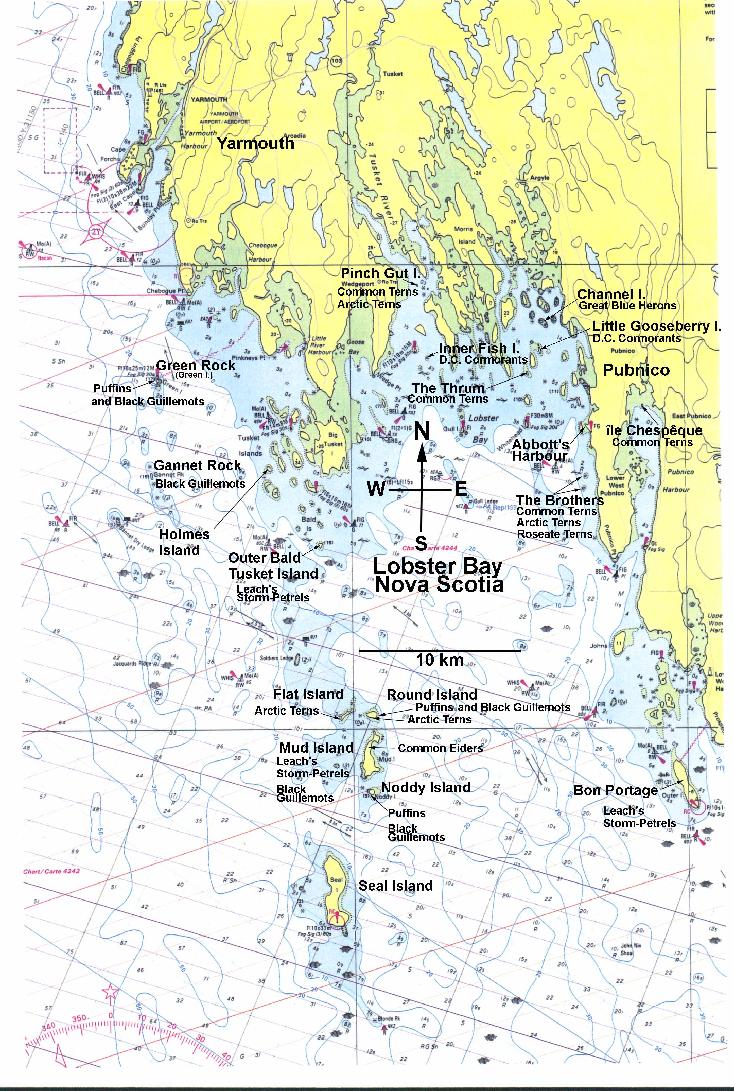TERN REPORT - 2008 - Ted C. D'Eon
LOBSTER BAY - SOUTHWEST NOVA SCOTIA
 TERN REPORT 2009 |2007 |2006 |2005 | 2004 | 2003 | 2002 | 2001 | 2000 | 1999 | 1998 | 1997 | 1996 | 1995
TERN REPORT 2009 |2007 |2006 |2005 | 2004 | 2003 | 2002 | 2001 | 2000 | 1999 | 1998 | 1997 | 1996 | 1995
Marine Chart of Lobster Bay
The Brothers are two tiny islands about 1 km west of Lower West Pubnico, Nova Scotia, Canada.
They are owned by the province and were designated a wildlife management area in April 2007.
Access to them during nesting season (April 1 to Aug. 31) is by permit only.My work on these islands is done in cooperation with Canadian Wildlife Service and the Nova Scotia Department of Natural Resources.
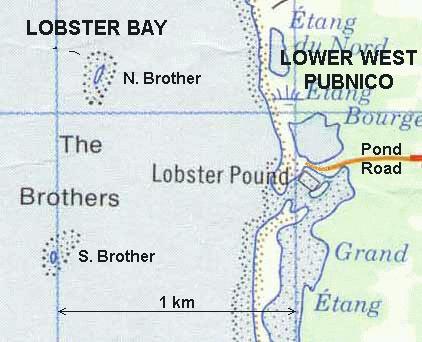 |
| THE BROTHERS, Yarmouth County, Nova Scotia |
SUMMARY OF OBSERVATIONS AND ACTIVITIES:
The following is a synopsis of the tern status in southwest Nova Scotia for the 2008 nesting season. My "tern" work and observations deal primarily with the tern colony on The Brothers. These two tiny islands are located about 1 km offshore from Lower West Pubnico in Yarmouth County.
 In April and early May, 2008, 27 new 16in. x 16in. Roseate Tern (ROST) nesting shelters were placed on N. Brother. Most of these boxes were placed on landscape fabric adjacent to and to the south of the main ROST nesting site, in an area of long grasses. This area is never used by terns of any species for nesting. Beach gravel was placed on the fabric before the placement of the shelters. This would improve their success rate.
In April and early May, 2008, 27 new 16in. x 16in. Roseate Tern (ROST) nesting shelters were placed on N. Brother. Most of these boxes were placed on landscape fabric adjacent to and to the south of the main ROST nesting site, in an area of long grasses. This area is never used by terns of any species for nesting. Beach gravel was placed on the fabric before the placement of the shelters. This would improve their success rate.
 Even though the number of terns on the Brothers was up in 2008, the tern colony did poorly.
Even though the number of terns on the Brothers was up in 2008, the tern colony did poorly.
 Total tern nests on The Brothers was 590 (only on North Brother again, in 2008). This was up from the 365 of 2007, down from 616 in 2006 and down from the high of 880 in 2001.
Total tern nests on The Brothers was 590 (only on North Brother again, in 2008). This was up from the 365 of 2007, down from 616 in 2006 and down from the high of 880 in 2001.
 There were 55 ROST nests on The Brothers in 2008. This was down from the 68 ROST nests there in 2007, 67 in 2006 and the 68 in 2005. The highest number of ROST nests on The Brothers was 90 in 2002.
There were 55 ROST nests on The Brothers in 2008. This was down from the 68 ROST nests there in 2007, 67 in 2006 and the 68 in 2005. The highest number of ROST nests on The Brothers was 90 in 2002.
 The maximum number of ROST chicks identified in 2008 was 16. This was down from the 62 in 2007. Only one ROST chick was found dead in 2008.
The maximum number of ROST chicks identified in 2008 was 16. This was down from the 62 in 2007. Only one ROST chick was found dead in 2008.
 No banding of ROST chicks in 2008. In 2007, 34 ROST chicks were banded on N. Brother. The highest number of ROST chicks to be banded on N. Brother was 44 ROST in 2002.
No banding of ROST chicks in 2008. In 2007, 34 ROST chicks were banded on N. Brother. The highest number of ROST chicks to be banded on N. Brother was 44 ROST in 2002.
 No field-readable Roseate Tern leg bands were read in 2008. Some ROST were observed carrying leg bands. Thick vegetation in front of the birds made it difficult to read them.
No field-readable Roseate Tern leg bands were read in 2008. Some ROST were observed carrying leg bands. Thick vegetation in front of the birds made it difficult to read them.
 Two Great Black-backed Gull nests were removed from The Brothers in 2008 - Both nests from S. Brother.
Two Great Black-backed Gull nests were removed from The Brothers in 2008 - Both nests from S. Brother.
 Severe Great Horned Owl predation in 2008 on N. Brother. The owl(s) got a minimum of 23 adult terns of which 11 were ROST. Most of the other terns were Common Terns. It is more than likely that more terns, including ROST, were carried away whole to the mainland to feed its young. I assume the owl(s) also terrorized the tern colony at night.
Severe Great Horned Owl predation in 2008 on N. Brother. The owl(s) got a minimum of 23 adult terns of which 11 were ROST. Most of the other terns were Common Terns. It is more than likely that more terns, including ROST, were carried away whole to the mainland to feed its young. I assume the owl(s) also terrorized the tern colony at night.
 I believe the owl problem started with the arrival of Meadow Voles (Microtus pennsylvanicus) on N. Brother during the fall/winter 2007/08. (Meadow Voles were first seen on S. Brother in April 2002.)
I believe the owl problem started with the arrival of Meadow Voles (Microtus pennsylvanicus) on N. Brother during the fall/winter 2007/08. (Meadow Voles were first seen on S. Brother in April 2002.)
My assumption is that the owls were feeding on the voles before the terns arrived, and once the terns were there, they were just another and an easily captured food supply.
The voles have also changed the landscape of N. Brother. The grasses have gone and have been replaced a plant which looks somewhat like a "mild water-pepper". The other primary plants on the island include a mustard species, Ragweed, and a large plant of the parsnip family. By Oct. 21/08 the voles had about 1/3 of the island looking as if the vegetation had been sprayed with an herbicide. There was extensive dead vegetation; the soil riddled with runways and burrows.
 On June 24, Julie McKnight and Brad Toms of CWS arrived to N. Brother with a leg-hold trap to capture the suspected Great Horned Owl. The trap had its jaws padded with neoprene rubber to prevent serious injury to the owl.
On June 24, Julie McKnight and Brad Toms of CWS arrived to N. Brother with a leg-hold trap to capture the suspected Great Horned Owl. The trap had its jaws padded with neoprene rubber to prevent serious injury to the owl.
The owl was live-captured on June 28 and taken away. There was no more tern predation after that. The colony, however, would not recover.
I feel something will have to be done to eliminate the voles from N. Brother before the 2009 tern nesting season. Late winter may be a good time to tackle the problem.
 We had a lot of foggy weather during the summer of 2008. This did not appear to be a factor in the low productivity of the tern colony.
We had a lot of foggy weather during the summer of 2008. This did not appear to be a factor in the low productivity of the tern colony.
 July 23, 2008 - Pubnico Harbour: Île Chespêque - About 25 fledged Common Tern chicks - no unfledged chicks; a few unhatched eggs. This is the most successful year for terns on this island I have ever seen. The Common Terns nest every year on this very low island. Rarely do any chicks survive to fledge due to storm tides, owls, and gulls.
July 23, 2008 - Pubnico Harbour: Île Chespêque - About 25 fledged Common Tern chicks - no unfledged chicks; a few unhatched eggs. This is the most successful year for terns on this island I have ever seen. The Common Terns nest every year on this very low island. Rarely do any chicks survive to fledge due to storm tides, owls, and gulls.
 July 23, 2008 - Pubnico Harbour: Île Ferrée - I saw only two fledged Common Terns and no unfledged chicks. There were still a few unhatched eggs - also about 25 terns in the air above me - all Common Terns except for one Arctic Tern.
July 23, 2008 - Pubnico Harbour: Île Ferrée - I saw only two fledged Common Terns and no unfledged chicks. There were still a few unhatched eggs - also about 25 terns in the air above me - all Common Terns except for one Arctic Tern.
 The Puffins on Noddy Island, Round Island and Green Island (a.k.a. Green Rock, 43 41.4N, 66 08.6W) appeared to be doing well. On August 2, 2008, I estimated about 120 Puffins at Noddy Island. This was by far the greatest number I have ever seen there.
The Puffins on Noddy Island, Round Island and Green Island (a.k.a. Green Rock, 43 41.4N, 66 08.6W) appeared to be doing well. On August 2, 2008, I estimated about 120 Puffins at Noddy Island. This was by far the greatest number I have ever seen there.
 On Green Island the number of Razorbills was more than double that of previous years. We estimated about 25 Razorbills coming out from the rocks there on July 12, 2008.
On Green Island the number of Razorbills was more than double that of previous years. We estimated about 25 Razorbills coming out from the rocks there on July 12, 2008.
 Soil erosion on The Brothers: In August 2007, I placed several wooden stakes at the south-west corner of N. Brother, a metre from the edge of the eroding bank of turf and glacial till. The purpose was to measure the amount of bank erosion over the winter.
Soil erosion on The Brothers: In August 2007, I placed several wooden stakes at the south-west corner of N. Brother, a metre from the edge of the eroding bank of turf and glacial till. The purpose was to measure the amount of bank erosion over the winter.
Results: By April, 2008, the island lost about 2/3 metre of land mass at its southern tip and about 1/3 metre along the south-west edge. The stakes were removed when the owl problem became apparent and I feared the owl might use the stakes as roosts. I should have placed some ground level markers to mark the location of the stakes after their removal.
On Oct. 21, 2008, I placed 12 plastic pegs 1 to 2 metres apart and one metre from the edge of the eroding south-west corner of N. Brother. The effects of Hurricane Kyle (Sep. 28/08) were apparent, but with none of the 2007 markers in place, I could not quantify the amount of erosion.
OBSERVATIONS:
 The following is a chronological listing of my 2008 work with terns in general, of the Lobster Bay area, but especially with the Roseate Terns (ROST) of The Brothers. The report also includes tern observations from other local residents.
The following is a chronological listing of my 2008 work with terns in general, of the Lobster Bay area, but especially with the Roseate Terns (ROST) of The Brothers. The report also includes tern observations from other local residents.
 |
| North Brother (2005 photo) |
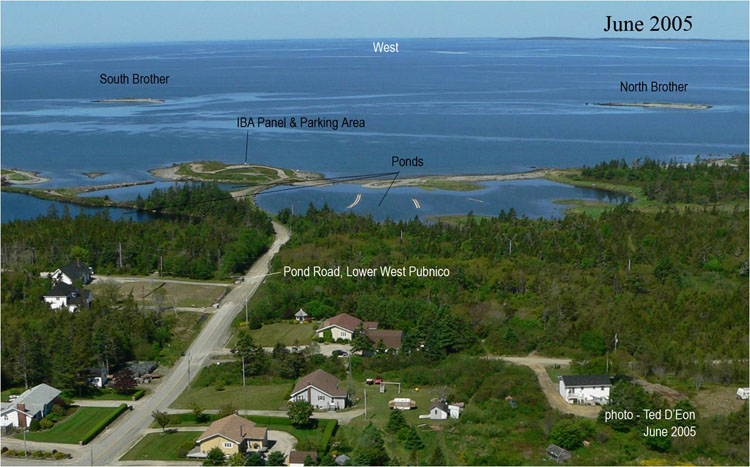 |
| The Brothers as seen from Lower West Pubnico. (2005 photo) |
April 17, 2008 - The first visit to The Brothers for 2008. I was assisted by Rémi d'Entremont and Jean-Bernard d'Entremont.
We had brought with us nine new 16in. x 16in. Roseate Tern nest boxes/shelters. Most of these boxes were placed on landscape fabric adjacent to and to the south of the main ROST nesting site, in an area of long grasses. This area is never used for nesting by terns of any species.
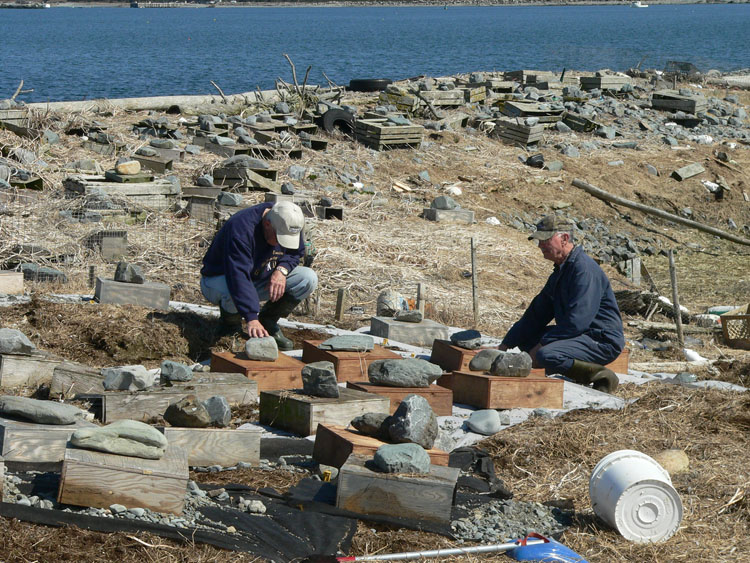 |
| The brown nesting boxes are the new ones - N. Brother, April 17, 2008 |
 |
| 16in. x 16in. Roseate Tern nest boxes |
To our surprise, we discovered the island to be infested with Meadow Voles (Microtus pennsylvanicus). To my knowledge, North Brother has never had any resident mammals before. Meadow Voles were first observed on South Brother in April 2002. I assume they swam there.
 |
| ROST Nesting box filled with Meadow Vole nesting material - N. Brother, April 17, 2008 |
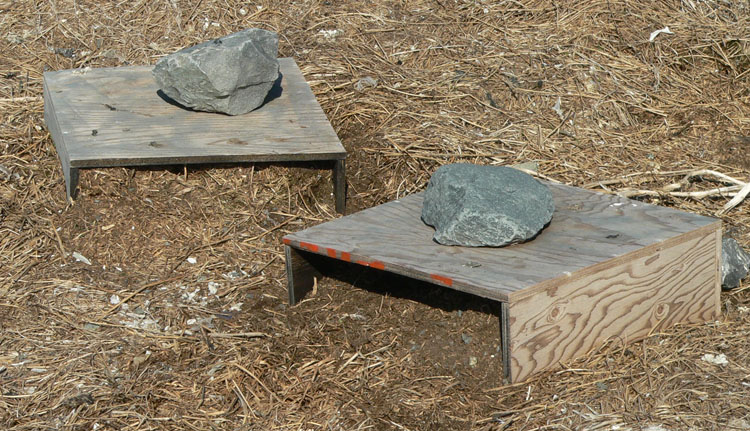 |
| More ROST Nesting boxes filled with Meadow Vole nesting material - N. Brother, April 17, 2008 |
 |
| Meadow Vole (Microtus pennsylvanicus) - N. Brother, April 17, 2008 |
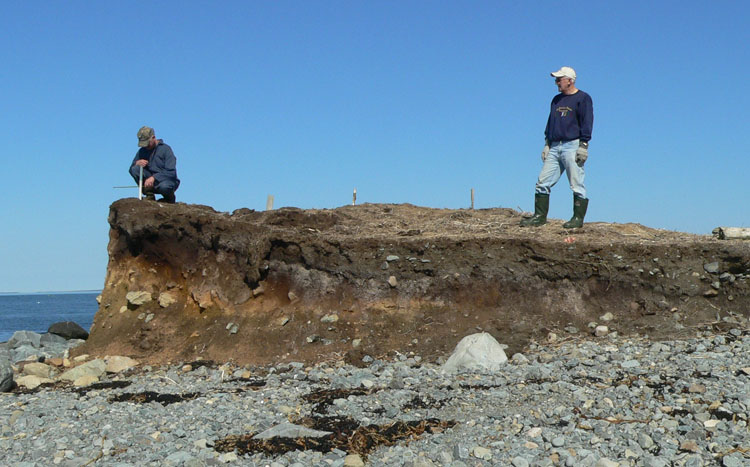 |
| Soil Erosion - a problem on The Brothers - N. Brother, April 17, 2008 |
In August 2007, I had placed several wooden stakes at the south-west corner of N. Brother, a metre from the edge of the eroding bank of turf. The purpose was to measure the amount of bank erosion over the winter.
Results: The island lost about 2/3 metre of land mass at its southern tip and about 1/3 metre along the south-west edge.
 |
| N. Brother looking north from southern tip - April 17, 2008 |
April 22, 2008 - The second visit to N. Brother to prepare the island for the arrival of the terns in early May. Today, we cleared up more dead vegetation from the primary ROST nesting area and reset previously unproductive nesting structures on gravel-covered squares of landscape fabric.
 |
| Aldric d'Entremont cleaning up the main ROST nesting area |
 |
| ROST nesting boxes set onto landscape fabric squares |
My crew and assistants - Jean-Bernard d'Entremont, his brother Aldric, and Andrea Atkinson.
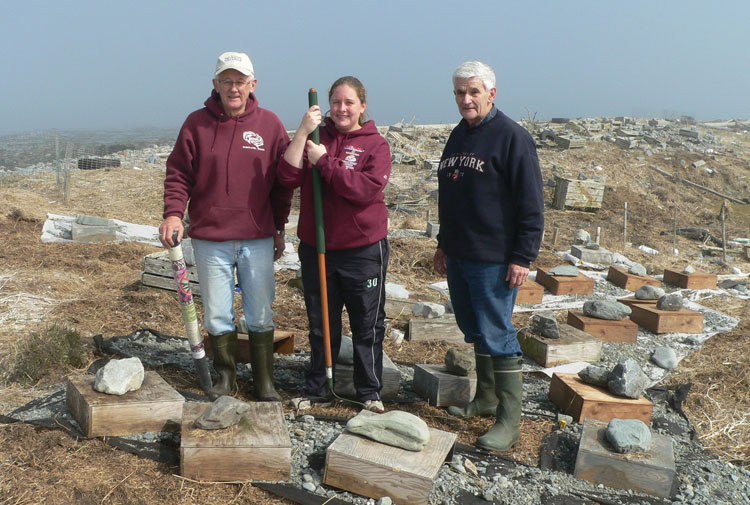 |
| My assistants - Jean-Bernard d'Entrtemont, Andrea Atkinson, and Aldric d'Entremont |
April 26, 2008 - My son, Nigel, and I placed another 9 Roseate Tern nest boxes on N. Brother.
April 28, 2008 - The terns have arrived in the area. An unofficial report through local lobster fishermen that two "Mackerel Gulls" were seen resting on buoys to the west of Seal Island. It will be a few more days before they will be seen at The Brothers. (Note: terns are sometimes referred to as "Mackerel Gulls" in south-west Nova Scotia".)
May 3, 2008 - I have been informed that lobster fisherman, Franklyn Surette, reported seeing terns at The Brothers this morning.
May 3, 2008 - Another 9 ROST nest boxes were placed on N. Brother. This brings the total of new nesting boxes placed on N. Brother this spring to 27.
We noticed the Meadow Voles are already vandalizing the landscape fabric. They have chewed many holes in the material. I did not see any holes in fabric which had been covered over with gravel, as had been done so inside the nest boxes.
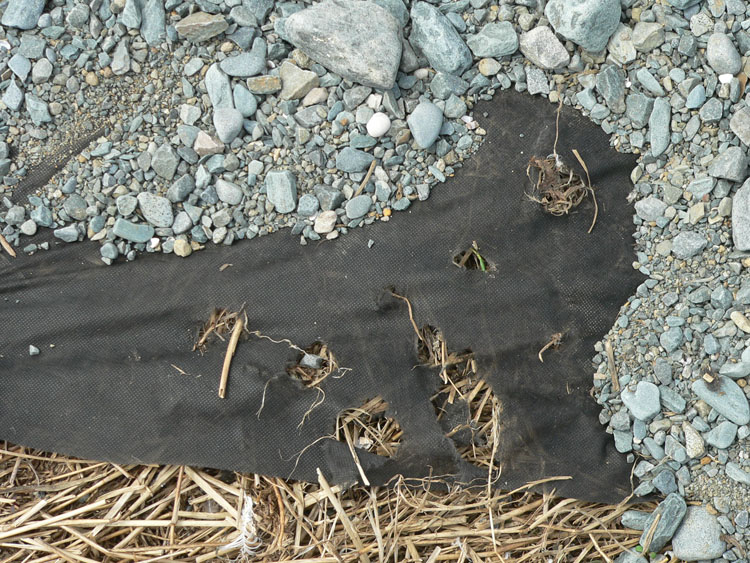 |
| Meadow Vole damage |
 |
| Crew and assistants: Clayton, Jean-Bernard, Jim and Henri |
My crew and assistants: Jean-Bernard d'Entremont, Henri d'Entremont, Clayton d'Eon and Jim Gray.
May 15, 2008 - We estimated about 60 terns at N. Brother. They appeared to be all Commons except for two Roseates. I was surprised not to see any Arctic Terns. It is possible there were some there and I just missed seeing them.
There was a Crow being "dive bombed" by the terns as we arrived on the island. We later found a decapitated Herring Gull we assume the Crow was feeding on. Its carcass was disposed in the water on the lee side of the island. We later found it well on its way to the mainland.
 |
| Headless Herring Gull carcass on N. Brother - May 15, 2008 - Ted D'Eon photo |
Also on N. Brother was a Commom Eider nest containing one egg.
We then visited South Brother. There were no terns there. We destroyed two Great Black-backed Gull nests each containing 3 eggs.
 |
| 2 Gull nests were removed from The Brothers in 2008 |
We also removed two cripple Herring Gulls from S. Brother. They each had a broken wing. (Somebody shooting gulls around here?)
My crew:Rémi d'Entremont, Margie Rogers and Michel d'Entremont.
May 20, 2008 - I viewed The Brothers from the mainland at the end of Pond Road, Lower West Pubnico.
Lots of terns at N. Brother "dive bombing" something on the island. After a while a Raven or a Crow was chased away from the island. I first thought it was a crow and I am still not sure that it was not. During its exit it made an evasive roll often seen performed by Ravens. I do not recall seeing a Crow execute such an aerial manoeuver. It flew to the mainland.
May 24, 2008 - I BELIEVE WE HAVE A PROBLEM! I arrived on N. Brother this morning and was greeted by 4 Crows busy being attacked by several hundred terns. What was going on?
First, we find a fresly dead adult male Common Eider with no visible cause of death on the beach of east side of the island. Then we find female Common Eider down and feathers scattered among the Roseate Tern nest boxes. Not far away was the carcass of the eider along with parts of at least two terns. This is what the Crows were feeding on.
The nest of the Common Eider found here on May 15 had been depredated. The empty shells of 2 Common Eider eggs were found.
Some tern feathers were seen inside a ROST nesting box as if a predator fed on a tern in there. I am puzzled as to how they got there and by what animal.
 |
| Tern feathers inside ROST nesting box, May 24, 2008 - Ted D'Eon photo |
The bird parts and carcasses were collected and brought to the mainland for incineration.
 |
| Removed from N. Brother on May 24, 2008 - Ted D'Eon photo |
My thoughts on this: The concentration Meadow Voles on N. Brother is attracting Great Horned Owl(s) to the island which are, in turn, taking the opportunity to prey on eiders, gulls and terns. The left-overs are scavenged by the Crows. Just some thoughts. I will contact Canadian Wildlife Service (CWS) for advice on what, if anything, can be done.
The dead male Common Eider on the beach is a bit of a mystery at the moment.
The Arctic Terns are back and we saw a few more Roseates. No tern nests were found, though there were signs of gull nest-building.
My crew: Nigel D'Eon and Alix d'Entremont.
May 25, 2008 - Seaweed harvester, David Surette, reported seeing about 100 terns at Île Chespêque in Pubnico Harbour.
May 30, 2008 - The tern colony on The Brothers is not well. Though the terns have begun nesting, tern eggs are being depredated by what I believe to be Crow. We found four empty tern egg shells below the overhanging bank of soil at the south-west end of N. Brother. How many more were removed from the island by an avian predator is anyone's guess.
 |
| The effects of Crow and Owl on a tern colony - Ted D'Eon photo |
The owl(s) got 2 or perhaps 3 more terns (Common Terns) since May 24. We brought the remains to shore for incineration.
We found about 25 tern nests containing 1 or 2 eggs. (Mostly Common Tern's but also a few Arctics.)
THERE STILL APPEARS TO BE ONLY ONE PAIR OF ROSEATE TERNS ON THE BROTHERS. I am concerned as to where they all could be.
We located a new Common Eider nest containing 2 eggs.
My crew and assistants:My son, Nigel, my daughter, Ingrid, and Ingrid's friends, Lolly and Kris.
June 2, 2008 - Nigel and I visited N. Brother this afternoon. The island and the tern colony were peaceful and vibrant. I estimated about 200 tern nests though we did not do an actual count.
There were no new signs of predation of terns or eggs since my visit there on May 30.
A few more Roseate Terns were observed, though their numbers still appeared very low.
June 3, 2008 - N. Brother again. This time Alix d'Entremont and Kelley Amirault assisted me.
There was no evidence Crows had been on the island since the day before. There was, however, another owl kill of a Common Tern. Its remains were collected and removed from the island.
The terns appeared happy and the colony was peaceful and vibrant. There is a possibility the number of Roseates is increasing.
June 5, 2008 - N. Brother. One more tern taken by the owl since June 3. This time it is an Arctic Tern. No other predation seen there at this time. The remains of the Arctic Tern were removed from the island.
Today, I saw Roseate Terns among the nesting boxes. I believe the number of Roseate Terns is still on the increase.
Crew and assistants: Nigel and Rémi.
June 8, 2008 - Nest count day on N. Brother.
Tern Nests Numbers on The Brothers - 1990 to 2007
| | N. Brother | S. Brother | totals |
| June 7, 1990 | 302 | 28 | 330 |
| June 11, 1991 | 441 | 13 | 454 |
| June 11, 1992 | 413 | 0 | 413 |
| June 9, 1993 | 367 | 0 | 367 |
| June 8, 1994 | 380 | 0 | 380 |
| June 14, 1995 | 457 | 0 | 457 |
| June 16, 1996 | 554 | 12 | 566 |
| June 12, 1997 | 630 | 120 | 750 |
| June 11, 1998 | 452 | 151 | 603 |
| June 7, 1999 | 399 | 0 | 399 |
|
| | N. Brother | S. Brother | totals |
| June 10, 2000 | 491 | 0 | 491 |
| June 9, 2001 | 817 | 63 | 880 |
| June 13, 2002 | 655 | 178 | 833 |
| June 13, 2003 | 648 | 102 | 750 |
| June 12, 2004 | 526 | 0 | 526 |
| June 13, 2005 | 445 | 0 | 445 |
| June 13, 2006 | 616 | 0 | 616 |
| June 10, 2007 | 365 | 0 | 365 |
| June 8, 2008 | 590 | 0 | 590 |
| | | | |
|
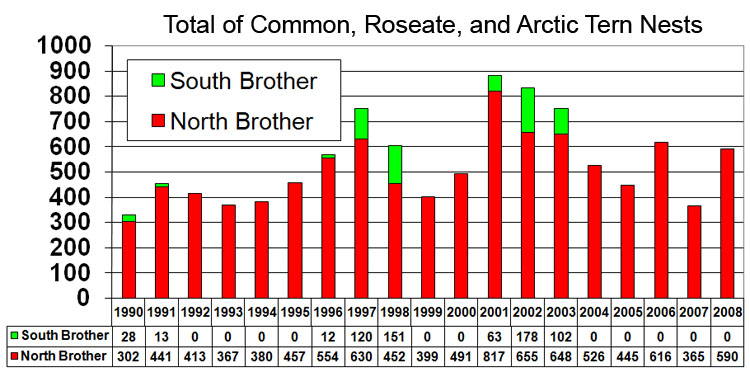 |
Note: little actual tern success in 2003 and 2004 - Mink predation
Serious Great Horned Owl predation in 2008 |
The good news - A total of 590 tern nests were counted of which 35 were Roseate Tern. These numbers were higher than I expected being that I had only seen a few pairs of Roseates at a time on previous visits. There was no new evidence of Crow predation on the island.
The bad news - There were six more owl kills of terns found on N. Brother since June 5, two of which were Roseate Terns. The others were all Common Terns. There was also one Common Tern found dead of unknown causes and there was a dead Storm Petrel which also looked like an owl kill, though I am not aware Petrels nest on The Brothers. I have never seen Storm Petrels there before. The remains of the dead birds were collected and brought home for incineration.
There are also two active Common Eider nests on N. Brother.
My crew and assistants: Rémi d;Entremont, Margie Rogers, and Andrea Atkinson.
June 20, 2008 - Julie McKnight and Brad Toms from Canadian Wildlife Service (CWS) were on The Brothers and found 4 more dead adult Roseate terns with evidence that they were killed by an owl (e.g. just heads).
June 24, 2008 - 14 more ROST nests were located on N. Brother bringing the total now to 49. This figure is still lower than I had hoped for.
 |
| Owl killed Roseate Tern - Ted D'Eon photo |
Another 4 more dead ROST killed by the owl(s). The bodies were gone or mostly gone. Only the heads remained. This makes it at least 10 Roseate Tern adults taken by the owl(s)!
My crew and assistants: Rémi, Nigel and Ingrid.
June 24, 2008 - 7pm - I assisted Julie McKnight and Brad Toms with the setting up of a non-lethal owl trap on N. Brother. It was placed on top of a post which had been attached to the observation platform.
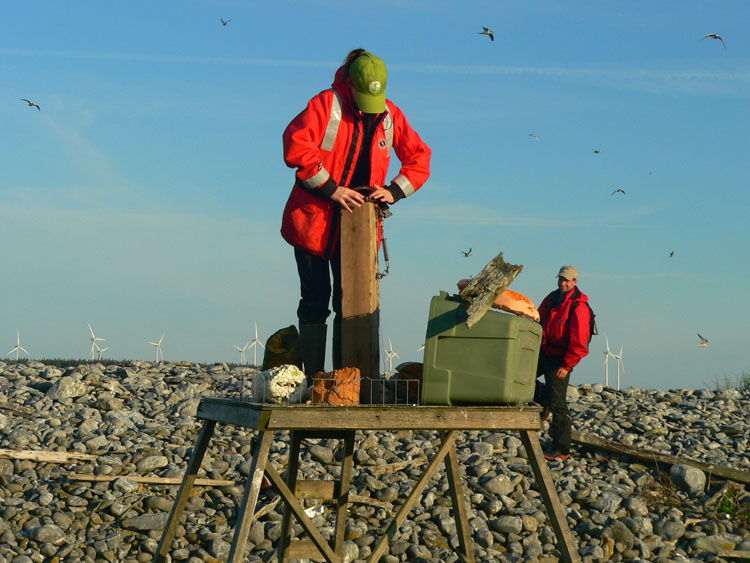 |
| Setting up the owl trap - Ted D'Eon photo |
June 25, 2008 - 5am - We headed out to N. Brother to check the trap. It had not been tripped and there were no new signs of new owl predation. The trap was disabled.
June 25, 2008 - 7:30pm - We returned to N. Brother to reset the trap for the night. Nothing else to report.
June 26, 2008 - 7am - Back to N. Brother and again nothing in the trap and no new signs of owl predation. The trap was tripped for the day.
The first tern chick was found. It was a Common Tern.
June 26, 2008 - 7:30pm - N. Brother; we reset the owl trap.
June 26, 2008 - Seaweed harvester, David Surette, reported about 50 tern nest about a week ago on Île Chespêque, Pubnico Harbour. One tern chick was in the process of hatching.
June 27, 2008 - 7am - Again, nothing in the owl trap.
June 28, 2008 - 7:30pm - N. Brother; we reset the owl trap. One more Roseate Tern nest was located in a nesting shelter. The total ROST nests now is 50.
Crew and assistants to Julie McKnight and me: Nigel D'Eon, Brian Hayes and Wally Hayes.
June 27, 2008 - 7am - Eureka!! Great Horned Owl trapped!
 |
| Great Horned Owl trapped on N. Brother, June 28, 2008 - Nigel D'Eon photo |
 |
| Great Horned Owl with Roseate Tern on N. Brother, June 28, 2008 - Julie McKnight photo |
The owl was placed in a box and taken away to be released at least 100km from Pubnico. That would be far enough that it would not be expected to return.
I must mention that the owl had a Roseate Tern in its talons when it tripped the trap. The dead ROST was next to it on the platform.
Nigel assisted Julie and I this morning.
July 1, 2008 - Quick trip to N. Brother. Owl trap setup was disasembled. A quick look around showed no new predation.
Crew and assistants: Nigel, Andrea Atkinson and Milton D'Eon.
July 6, 2008 - ROST chick and nest count on N. Brother.
ROST nest number up to 55 - also, 15 ROST chicks documented. The oldest was estimated to be about 7 days old.
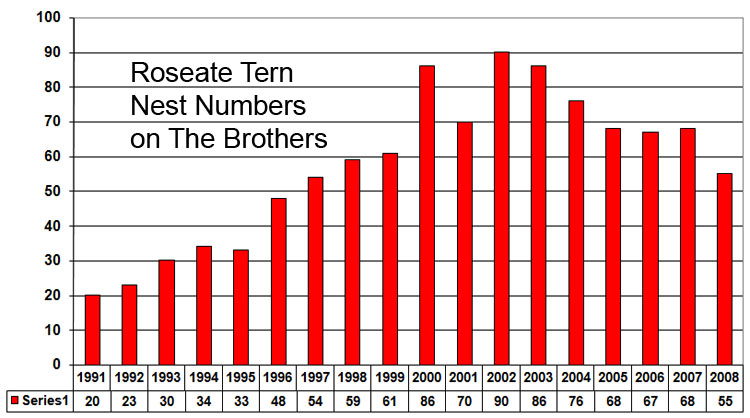 |
Note: little actual tern success in 2003 and 2004 - Mink predation
Serious Great Horned Owl predation in 2008
Note: in 2007, 62 ROST chicks were documented and most survived to fledge.
In 2008 the total number of ROST chicks identified on The Brothers fell to 16. |
There were no new signs of predation of any kind, although we did find 7 or 8 dead Common Tern chicks. Mortality from natural causes was assumed.
More ROST chicks are expected to hatch within the next few days.
Crew and assistants: Andrea Atkinson, Margie Rogers, and Michel d'Entremont.
.July 12, 2008 - Motored by N. Brother on my way to check out Green Island (a.k.a. Green Rock), 43 41.4N, 66 08.6W
The tern colony on N. Brother appeared fine from the boat with no obvious signs of predators.
The numbers of Puffins of Green Rock was similar to other years or maybe slightly down at 50 or so individuals. On the other hand, the number of Razorbills was more than double that of previous years. We estimated abour 25 Razorbills coming out from the rocks of Green Rock.
 |
| Razorbills and Puffins, Green Rock, NS, July 12, 2008 - Ted D'Eon photo |
The number of Double-crested Cormorants had about doubled also from last year.
July 15, 2008 - Quick visit to N. Brother. Still no signs of any predation.
We only located 5 or 6 ROST chicks. Our search was not thorough. One of those was found dead at the age of about 2 weeks. The youngest we found was about 6 days old. I am sure there were more of them hiding in the vegetation.
My crew and assistants: Rémi d'Entremont, Rory D'Eon, and his wife, Janice.
July 22, 2008 - I went to N. Brother to try to read leg bands. No success - vegetation too tall. It was difficult to see the terns, let alone their legs. Rémi assisted me.
 |
| Roseate Tern in the mustard, July 22, 2008 - Ted D'Eon photo |
July 23, 2008 - I checked out the two tern colonies in Pubnico Harbour.
Île Chespêque - About 25 fledged Common Tern chicks - no unfledged chicks; a few unhatched eggs. This is the most successful year for terns on this island I have ever seen. The Common Terns nest every year on this very low island. Rarely do any chicks survive to fledge due to storm tides, owls, and gulls.
Île Ferrée - I saw only two fledged Common Terns and no unfledged chicks. There were still a few unhatched eggs - also about 25 terns in the air above me - all Common Terns except for one Arctic Tern.
July 26, 2008 - N. Brother. We did not locate any ROST chicks of banding age that were not already fledged. We did, however, find a newly hatched, 2 day old ROST in one of my nest boxes. I expect its parents will head south before it is fledged as most terns leave the island in early August, but that is the way it is..
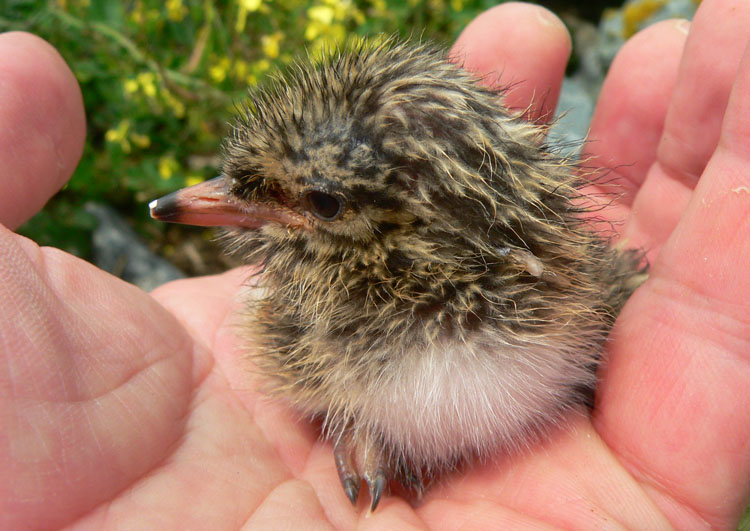 |
2 day old Roseate Tern chick, July 26, 2008 - Ted D'Eon photo
This brings the total ROST chick number on The Brothers to 16 for 2008.
Note: in 2007, 62 ROST chicks were documented and most survived to fledge. |
Also I would think banding ROST is pretty well out of the question for this year.
There were still a good number of unfledged Common and Arctic Terns (but mostly Common) scurrying about mostly at the perimeter of the nesting area and the beach, and the island was very busy.
I must mention that the unproductive area adjacent to the main ROST nesting area, where I placed about 20 nesting shelters on landscape fabric, has had some limited success. Four of the shelters were used.
I must also mention that for the past number of years, this was an area of long grasses. This year the "grasses" have all been replaced by a mustard, a plant which looks somewhat like a "mild water-pepper", Ragweed, and a large plant of the parsnip family. The grasses have disappeared. I assume this is the work of the Meadow Vole. Whether this is good or bad, I don't know, but the vegetation is awefully thick and my nesting shelters have all but disappeared into it.
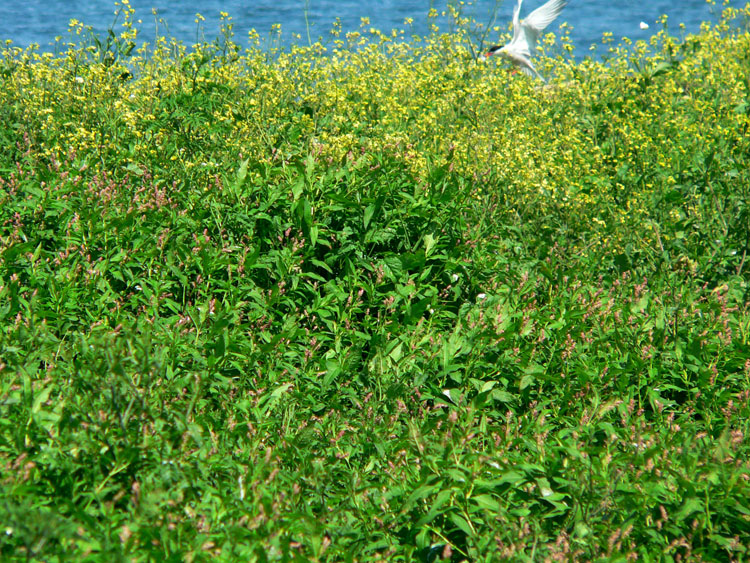 |
| Some of the vegetation on N. Brother, 2008 - Ted D'Eon photo |
Rémi d'Entremont assisted me.
July 31, 2008 - N. Brother. Still many tern chicks, fledged and not quite fledged, being fed by their parents. The 2 day old ROST chick of July 26 (now about 7 days old) was found in the same nesting shelter as first seen.
All appeared well on the island.
Crew and assistants: Roland D'Eon and Nick Mattison.
August 2, 2008 - Motored by N. Brother on the way to check out the birds on "the Mud Islands".
Lots of young terns at the water's edge of N. Brother being fed by adults. Very few Roseate Tern chicks could be seen among them.
Puffins - There were about a dozen at the east end of Round Island with about three times as many Black Guillemots. We did not land on Round Island.
I estimated about 120 Puffins at Noddy Island. This was by far the greatest number I have ever seen there. Most of these birds were in the south-west cove of the island. We did not land on Noddy Island.
We then motored to Flat Island where we were able to tie to what was left of a wharf and walked through a small Arctic Tern colony. The Arctic chicks were all flying except for one which seemed old enough but was crouched in the beach rocks, and one Arctic chick which was in the process of hatching. There were also several species of shorebirds on Flat I., including Semipalmated Sandpipers, Semipalmated Plovers, Short-billed Dowitchers, Greater Yellowlegs and Ruddy Turnstones.
In January 2008, when I visited the Grey Seal colony on Flat I., a half a dozen adult Grey Seals had recently been shot and killed there. This was my first visit there since then and I was interested to see what remained of the carcasses after 8 months.
It was strange and unexpected to find most of them in the center of 4 or 5 metre diameter patches of what appeared to be tilled earth (see photo below). I assume this was made birds - I am not aware of any mammals on the island which could have done this. Anyway, it was strange.
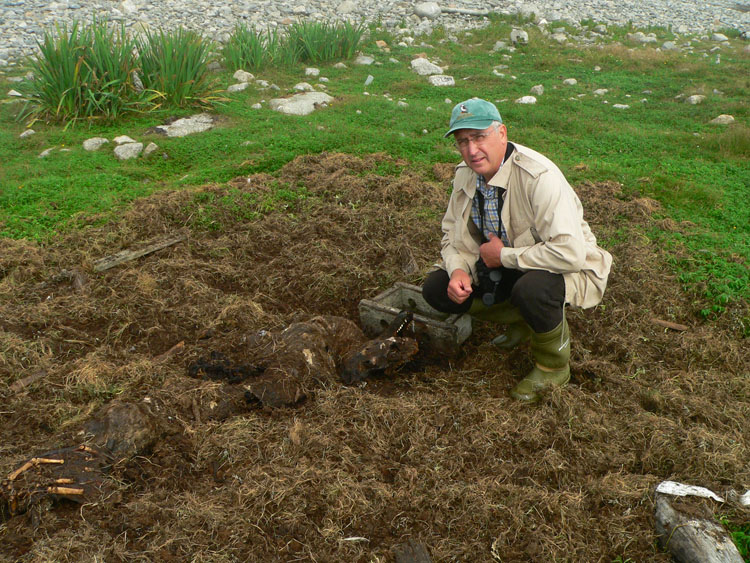 |
| Adult Grey Seal carcass, Flat I., Aug. 2/08 - Roland D'Eon photo |
Most of the trip was shrouded in thick fog. The fog cleared the last few kilometres as we approached Abbott's Harbour on our way back. It was a good and productive trip just the same.
Crew and guests: John and Lynne Gartley, Joan ?, and my brother, Roland.
August 13, 2008 - N. Brother for a quick visit.
The ROST chick which was about a week old on July 31 was no longer in its nesting shelter though there was lots of evidence (droppings) that it had survived at least for quite some time and possibly was still alive.
Before too long I saw a recently fledged ROST chick flying around anf waiting to be fed. I assume this was the same chick as was in the shelter on July 31. This was the only ROST chick to be seen on this day. There were also a few fledged Common Tern chicks waiting for food and perhaps 20 or so adult terns in the air. It appeared the other terns of the colony had already left the island to prepare for their migration south.
Below, I have a photo of the vegetation on N. Brother on Aug, 13, 2008, and below that, a photo showing the vegetation there on June 21, 2007. No grass grew in 2008 in the long grass area of 2007, where we placed about 20 nesting shelters on landscape fabric in April/08. In April there was only dead, brown vegetation. In 2008, this grass had been replaved by other vegetation.
Are these the effects of Meadow Voles on the island?
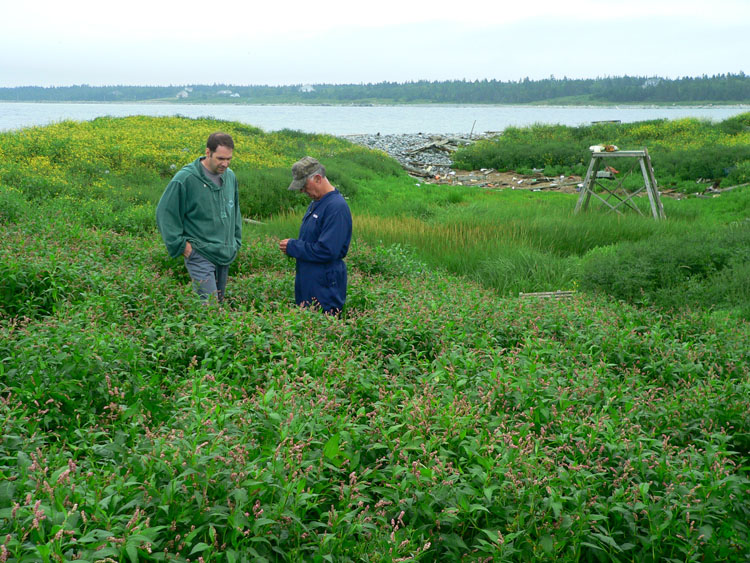 |
| The vegetation has changed - N. Brother, Aug 13, 2008 - Ted D'Eon photo |
 |
| The vegetation on N. Brother on June 21, 2007 - Ted D'Eon photo |
Crew: Rémi d'Entremont and Roland D'Eon.
October 21, 2008 - N. Brother: I placed 12 plastic pegs 1 to 2 metres apart and one metre from the edge of the eroding south-west corner of N. Brother. The effects of Hurricane Kyle (Sep. 28/08) were apparent, but with none of the 2007 markers in place, I could not quantify the amount of erosion.
In August 2007, I had placed several wooden stakes at the south-west corner of N. Brother, a metre from the edge of the eroding bank of turf and glacial till. The purpose was to measure the amount of bank erosion over the winter.
The voles have also changed the landscape of N. Brother. The grasses have gone and have been replaced a plant which looks somewhat like a "mild water-pepper". The other primary plants on the island include a mustard species, Ragweed, and a large plant of the parsnip family. By Oct. 21/08 the voles had about 1/3 of the island looking as if the vegetation had been sprayed with an herbicide. There was extensive dead vegetation; the soil riddled with runways and burrows.
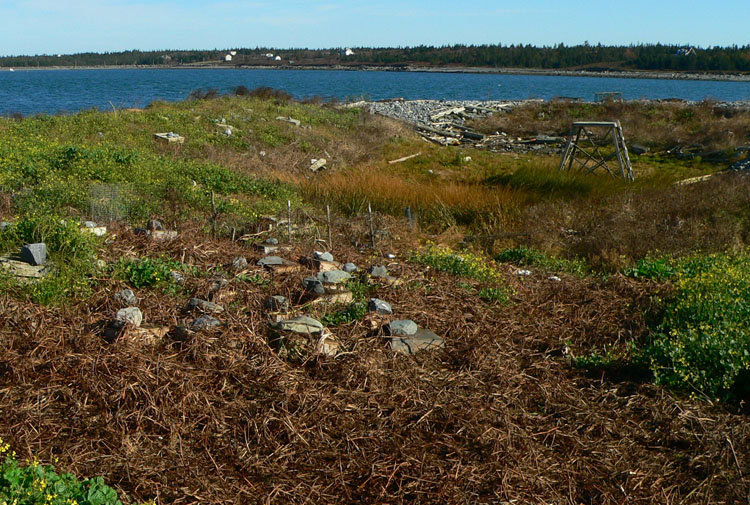 |
| The vegetation on N. Brother on Oct 21, 2008 - Ted D'Eon photo |
 |
| Meadow Vole damage - N. Brother, Oct 21/08 - Ted D'Eon photo |
Marine Chart of Lobster Bay, Nova Scotia
Click on the chart to enlarge.
Ted C. D'Eon
P.O. Box 14
Middle West Pubnico
Nova Scotia B0W 2M0
Canada
phone (home)1-902-762-2097
(cell)1-902-749-6883
E-Mail to: ted@ns.sympatico.ca
© Ted C. D'Eon, 2008


 In April and early May, 2008, 27 new 16in. x 16in. Roseate Tern (ROST) nesting shelters were placed on N. Brother. Most of these boxes were placed on landscape fabric adjacent to and to the south of the main ROST nesting site, in an area of long grasses. This area is never used by terns of any species for nesting. Beach gravel was placed on the fabric before the placement of the shelters. This would improve their success rate.
In April and early May, 2008, 27 new 16in. x 16in. Roseate Tern (ROST) nesting shelters were placed on N. Brother. Most of these boxes were placed on landscape fabric adjacent to and to the south of the main ROST nesting site, in an area of long grasses. This area is never used by terns of any species for nesting. Beach gravel was placed on the fabric before the placement of the shelters. This would improve their success rate.


































